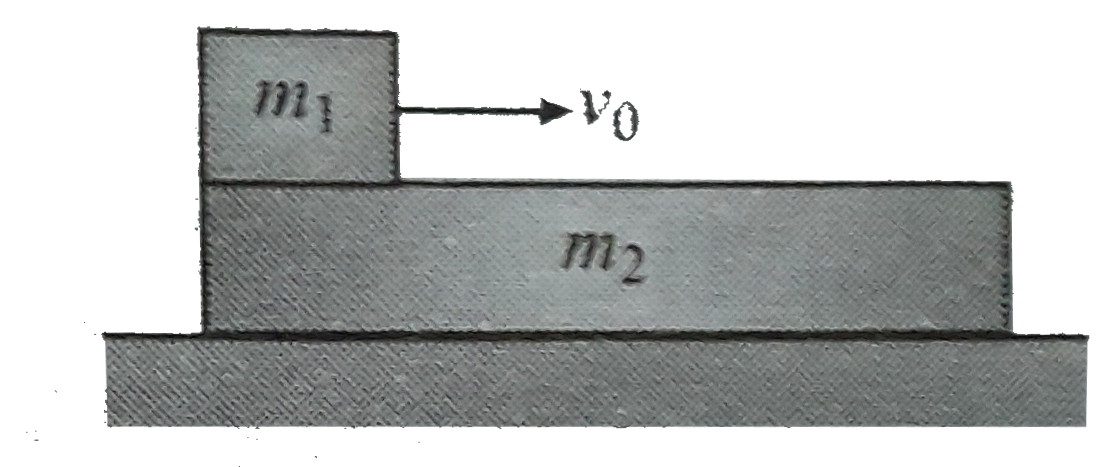A body of mass 10 kg initially at rest acquires velocity 10ms−1. What is the work done ?
(a)−500J
(b)500 J
(c)50 J
(d)−50J
The correct Answer is:B
To solve the problem, we need to calculate the work done on a body of mass 10 kg that goes from rest to a velocity of 10 m/s. We can use the work-energy principle, which states that the work done on an object is equal to the change in its kinetic energy.
1. Identify the mass and initial velocity:
- Mass (m) = 10 kg
- Initial velocity (u) = 0 m/s (since the body is initially at rest)
2. Identify the final velocity:
- Final velocity (v) = 10 m/s
3. Calculate the initial kinetic energy (KE_initial):
- The formula for kinetic energy is given by:
KE=12mv2
- Since the initial velocity is 0, the initial kinetic energy is:
KEinitial=12×10kg×(0m/s)2=0J
4. Calculate the final kinetic energy (KE_final):
- Now, we calculate the final kinetic energy when the body reaches a velocity of 10 m/s:
KEfinal=12×10kg×(10m/s)2
- This simplifies to:
KEfinal=12×10×100=500J
5. Calculate the work done (W):
- The work done is equal to the change in kinetic energy:
W=KEfinal−KEinitial
- Substituting the values we calculated:
W=500J−0J=500J
Final Answer:
The work done on the body is 500 Joules.
---
- Mass (m) = 10 kg
- Initial velocity (u) = 0 m/s (since the body is initially at rest)
- Final velocity (v) = 10 m/s
- The formula for kinetic energy is given by:
KE=12mv2
- Since the initial velocity is 0, the initial kinetic energy is:
KEinitial=12×10kg×(0m/s)2=0J
- Now, we calculate the final kinetic energy when the body reaches a velocity of 10 m/s:
KEfinal=12×10kg×(10m/s)2
- This simplifies to:
KEfinal=12×10×100=500J
- The work done is equal to the change in kinetic energy:
W=KEfinal−KEinitial
- Substituting the values we calculated:
W=500J−0J=500J
The work done on the body is 500 Joules.
Topper's Solved these Questions
Similar Questions
(Answer the following questions briefly and to the point :)
A constant retarding force of 100 N is applied to a body of mass 10 kg moving initially with a speed of 30 ms−1. What is the retardation of the body ?
View SolutionAt a place where the acceleration due to gravity is 10m sec−2 a force of 5 kg - wt acts on a body of mass 10 kg initially at rest. The velocity of the body after 4 second is
View Solution
Knowledge Check
A body of mass 10mg is moving with a velocity of 100ms−1. The wavelength of the de Broglie wave associated with it would be
A6.626×10−7mB6.626×10−34mC6.626×10−4mD6.626×10−35m
A body of mass 5 kg initially at rest is subjected to a force of 20 N. What is the kinetic energy acquired by the body at the end of 10 s?
View SolutionA force of 10 N acts on a body of mass 2 kg for 3s , initially at rest. Calculate the velocity acquired by the body
View SolutionA body of mass 10 kg is moving with a velocity of 20 m s−1 . If the mass of the body is doubled and its velocity is halved, find : (i) the initial kinetic energy, and (ii) the final kinetic energy
View SolutionA block of mass 1kg is horizontal thrown with a velocity of 10ms−1 on a stationary long of mass 2kg whose surface has a μ=0.5. Plane rest on friction surface find the time when m1 comes to rest w.r.t. plane

View SolutionA body of mass 5 kg moving on a horizontal surface with a velocity of 10ms−1 comes to rest in 2s. The force required to make this body move with a velocity of 10ms−1 on the same surface is
View SolutionA force is applied for a duration of 10sec on a body of mass 5kg that is at rest. As a result the body acquires a velocity of 2ms−1. Find the magnitude of the force applied.
View SolutionA body of mass 1kg is projected with velocity 50ms−1 at an angle of 30∘ with the horizontal. At the highest point of its path a force 10 N starts acting on body for 5s vertically upward besids gravitational force, what is horizontal range of the body (Take, g=10ms−2)
View Solution
